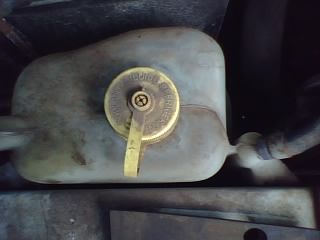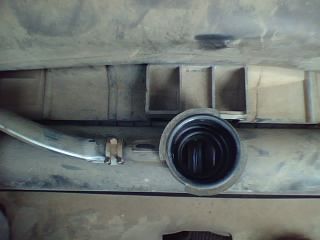
Serving the Gainesville and Hawthorne Florida Area










Radiator Repairs $75-$150
New radiator replacement $200=$600
Prices good for most domestic or import cars and light trucks)
Return to the Econofix Home Page
Auto, Car, Truck Radiators
What a Radiator Does
A radiator keeps a water cooled engine cool. It dissipates the heat created by the burning gas in your engine. The cylinders and head are surrounded by a "water jacket" which absorbs the heat of the burning fuel air mixture. The radiator then transfers this heat to air which flows through its fins.
Radiator Maintenance
The first and most obvious radiator and cooling system maintenance is to keep coolant in the system. Ideally this is a 50/50 or up to a 75/25 mix of a good brand of antifreeze and distilled water.
In practice, dirty ditch water transported in a coke cup is better than trying to "make it home" with an empty cooling system.
Adding Coolant
There is some confusion about where to add coolant. Most cars have a radaitor coolant recovery tank which often says "add coolant here".

Although it is important to keep coolant in this tank, if you have a coolant leak and add coolant only to the tank, you may not get any coolant into the radiator. YOUR CAR MAY STILL OVERHEAT!!!
CAUTION!!! DO NOT OPEN A RADIATOR CAP WHEN THE CAR IS HOT OR OVERHEATED!!!
If your car overheats, go get a drink somewhere, or listen to the radio fo a half hour or so. Give the radiator some time to cool off. If you don't have water, walk and get some.
Don't bother with the plastic coolant recvovery tank at this point: ON A COOL RADIATOR remove the pressure cap AT THE RADIATOR.

Fill the radiator with coolant. (or just water if you've got a leak: no point in polluting the ground water with antifreeze. If you suspect a leak, you might want to go with just water until you fix it. Leaving the radiator cap loose can slow down a cooling system leak. (Most caps click twice before fully tight: the first click releases the system pressure)
Only after you've filled the radiator to full capacity should you put any coolant in the plastic coolant recovery tank.
Since a slow leak can lose engine coolant without drawing new coolant from the plastic recovery tank, it's important to check your coolant level AT THE RADIATOR ITSELF from time to time (COOL ENGINE ONLY!!!)
If the radiator isn't completely full, the coolant recovery system (plastic tank) won't work at all.
How a Radiator Fails
A radiator can fail two ways: leaks and clogs. Running proper coolant mix is the preventative for both.
Although it's called a "water jacket", one of the nicest things you can do for your engine and radiator is to never run just water in it! Always run at least a 50/50 mix of antifreeze with water. WARNING: Do not run pure antifreeze! Do not exceed a 75/25 mix antifreeze to water! (They used to say never exceed a 50/50, but now the antifreeze jugs say 75/25! I suspect they've watered it down!)
Food for thought: Why not run distilled water in with that antifreeze instead of tapwater? Our water here is pretty hard, and a couple of gallons of distilled water only costs a couple of bucks....
Pre-Mixed Antifreeze
Be careful when you buy antifreeze: you'll find gallon bottles of stuff that looks just like the antifreeze but is slightly cheaper. WATCH OUT!!!
If it says "Pre-mixed coolant" or something like that, this is antifreeze with the water already added. A good thing about this would be if you're doing a complete cooling system overhaul and don't want to go to the trouble of buying distilled water and then calculating the exact ratio of antifreeze to water.
JUST DON'T THINK YOU'RE GETTING FULL STRENGTH ANTIFREEZE!!!
You'll come out cheaper providing your own water.
A CUTE TEST FOR A CLOGGED RADIATOR
Sometimes it's hard to tell if a radiator has enough flow. Here's a couple of quick tests. Although they're not as good as removing the radiator and flow checking it with a machine at the radiator shop, they can be done on the car and are fairly easy.
FIRST TEST
Feel the radiator fins as the engine warms up. As the thermostat opens, the entire radiator should start to get warm .WATCH OUT FOR THAT FAN!!!!!!!!!!!!!!! If only part of the radiator gets warm, it may be clogged in the cold areas.
SECOND TEST
Remove the radiator cap with the engine cold. Squeeze the top radiator hose to get a "feel" of how it squeezes under zero pressure. When the thermostat opens and you can see the coolant circulate, repalce the cap and IMMEDIATELY rev the engine up (3000 RPM or so) while squeezing the top radiator hose. The hose should remain fairly easy to squeeze. With a clogged radiator, you can actually feel the hose "stiffen up" and get hard to squeeze as the engine speed increases.
HOW TO FLUSH YOUR COOLING SYSTEM
The best flushes are two part: a strong acid and a neutralizer. The one part flushes aren't as strong.
The strong flushes get rid of more scale and deposits, but you run the risk of 'eating through" the extremely thin and cheap radiators, freeze plugs, and heater cores they have today.
Prestone and others make a "backflush adapter" which fits in a heater hose and accepts a garden hose.
No matter how you do it, I'd replace both the top and bottom hoses, bypass and heater hoses, and possibly the thermostat.
When you remove the bottom hose almost all the coolant will drain out of the system.
You really shouldn't just dump this coolant: be a little "green" and at least pour it down a drain so the wastewater treatment plant can deal with it before it gets in the groundwater!.
The best is to go to your regular mechanic and let him put it in his coolant recycling tank. Mechanics are required by law to have one.
Fill the system with water.
If you decide to use flush, add it at this time. Start the engine and let it warm up. It might be necessary to hold your hand over the radiator filler while squeezing the top hose: the thermostat will be closed and may keep the water from circulating. If no water touches the thermostat, it WILL NOT OPEN AND OVER HEAT YOUR VEHICLE!!!
I always drill an 1/16 inch hole in the flange of a thermostat to keep it from "air locking" like that: the better thermostats already have a bypass hole for this purpose.
Once it is warm, follow the can directions regarding the flush, if you use it. If you aren't using flush, skip these next few steps.
If it's a 2 part flush, remove the bottom hose or open the radiator drain cock if it has one. (the drain cock will usually be on the opposite side from the bottom hose inlet on the radiator.)
After it drains, replace the bottom hose and refill the system as outlined above. After it has been refilled, remove the top hose. Get a piece of pipe that fits either over or inside the top hose: this will make this step a lot neater.
Put a hose in the radiator filler and turn it on. Run the engine. Fresh water is being added by you via the radiator, the water in the engine is being pumped out of the top hose. Run water through it until the water exiting the top hose runs clear.
Re-attach the top hose and add the neutralizer, if a 2 part flush. Drain and repeat both of the above steps to remove the neutralizer from the system.
If a one part flush, as soon as the water runs clear you are ready for coolant. Drain the system as outlined above.
Reattach all hoses, put in the antifreeze first. Complete the fill with water.
Auto, Car, and Truck Article List
A
ABS: Anti-Lock Brake Systems
ADVANCE: Car ignition timing
ALTERNATORS and Car Battery
AUTOMATIC TRANSMISSIONS
B
BAD CAR DESIGNS
Bad Drivers: How NOT to drive
BATTERIES: Auto, Car or Truck
BELTS AND HOSES
BEARINGS
BODY AND BUMPER REPAIRS
BRAKE REPAIRS: Car or Truck
C
Car Washing and Care
CARBURETORS:Car & Truck
CHECK ENGINE LIGHT
CLEANING: Engine Cleaning
CLUTCH REPAIRS: Car & Truck
COMPRESSION: Car Engine
COMPUTER CAR CONTROLS
CV JOINT OR CV AXLES
D
DISTRIBUTORS (IGNITION)
E
ELECTRIC WIRING REPAIR
ENGINES: Car & Truck
ENGINE CLEANING
EXPANSION PLUGS
F
FILTERS: OIL, AIR, ETC.
FREEZE PLUGS
FUEL AIR MIXTURE
FUEL INJECTION: Car & Truck
FUEL PUMPS: Car & Truck
G
GAGES AND "IDIOT LIGHTS"
GASKETS AND SEALS
GLASS: WINDOWS AND WINDSHIELDS
H
HEADS & HEAD GASKET
HOSES AND BELTS
I
"IDIOT LIGHTS" AND GAGES
IGNITION TIMING: Car & Truck
J
AUTO JACKS: lifting cars safely
K
L
LEAN "Car runs lean"
LIGHTS: WARNING OR "IDIOT LIGHTS"
Limp Home Mode
M
MIL Light
MANUAL TRANSMISSIONS
N
NO START: Car Won't Start
O
OIL CHANGES
OIL: What's right for your car?
OIL LIGHT ON OR GAGE LOW
P
PCV Valve
Q
R
RADIATORS: Car and Truck
RICH: Car runs rich
S
SEALS AND GASKETS
SERVICE ENGINE SOON LIGHT
SPARK PLUGS
STARTERS: Auto, Truck
T
THERMOSTATS
TIMING: IGNITION TIMING
TIMING BELT & TIMING CHAIN
TIRE REPAIR
TRANSMISSIONS: AUTOMATIC
TRANSMISSIONS: MANUAL
U
V
VACUUM ADVANCE
WARNING LIGHTS OR "IDIOT LIGHTS"
Car Washing and Care
W
WATER PUMP REPAIR
WINDOWS AND WINDSHIELDS
WIRING REPAIR
X
Y
Z
RETURN TO THE ECONOMECHANIX HOME PAGE
Thank you for visiting the ECONOMECHANIX WEB SITE. Please feel free to comment.
>> CLICK HERE: The Econofix Cyber Mall!!! >














